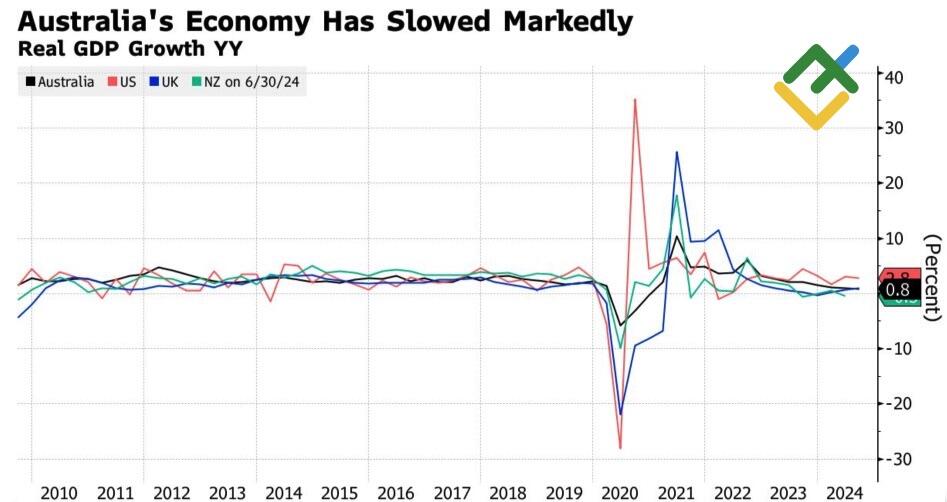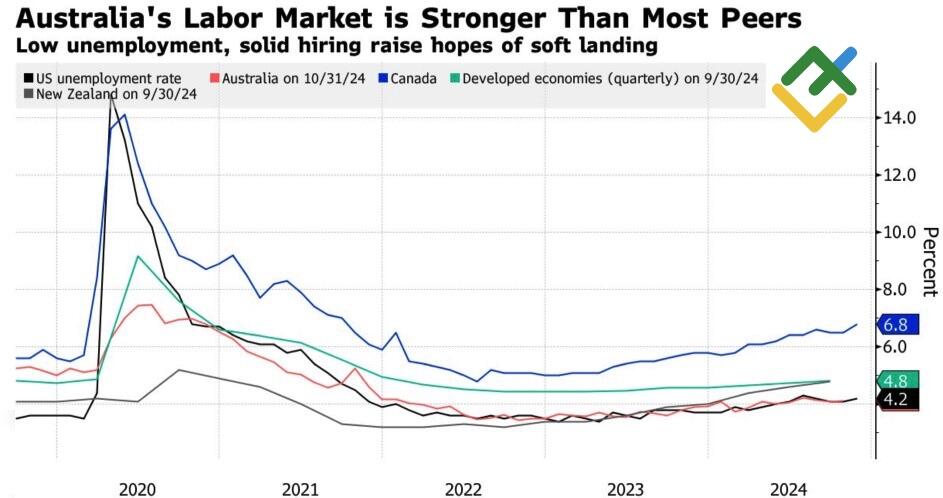
Australia’s GDP has reached its lowest levels since the 1990s, prompting the Reserve Bank to consider rate cuts. In light of the Federal Reserve’s intention to pause and the introduction of tariffs by the Trump administration, the AUDUSD pair is plummeting. Let’s discuss this topic and make a trading plan.
The article covers the following subjects:
Major Takeaways
- The RBA has abandoned the idea of hiking the cash rate.
- The Australian economy may become weaker.
- The labor market hampers the Reserve Bank’s rate cut.
- The AUDUSD pair continues to tumble to 0.615.
Weekly Fundamental Forecast for Australian Dollar
The Reserve Bank of Australia has refused to assume that the key interest rate can be lowered or raised, which dashed hopes of bulls to gain ground on the AUDUSD pair. The pair reached a 13-month low following the RBA’s dovish signals, and even the robust Australian labor market data could not impede the bearish sentiment.
According to Michele Bullock, some upside risks to inflation have diminished, although aggregate demand remains above the supply power of the economy. However, this discrepancy is gradually diminishing. As a result, the RBA is becoming increasingly confident that inflation will reach the target level. In light of this rhetoric, the derivatives market has increased the likelihood of a cash rate cut in February from 50% to 70%. In addition, Deutsche Bank has adjusted the timing of the RBA’s initial act of monetary expansion from May to February.
The derivatives market is projecting two acts of monetary easing by May, a prediction that Michele Bullock finds reasonable given the slowest GDP growth since 1990 in the third quarter and disappointing consumer and business confidence figures.
World’s Leading Economies’ GDP Growth
Source: Bloomberg.
The divergence between Australian and US economic growth has reinforced the downward trend in the AUDUSD pair, particularly in light of the potential for Donald Trump’s trade tariffs to exert further downward pressure. The Treasury has already reduced Australia’s GDP growth forecast for 2024–2025 from 2.25% to 1.75%. The budget is expected to fall short of its targets by AU$1.3 billion due to lower tax revenues from commodity sales, reflecting a decline in demand.
Against this backdrop, a pause in the Federal Reserve’s monetary expansion cycle and the Reserve Bank’s decision to reduce the cash rate could exert further pressure on the AUDUSD exchange rate. The only factor that can impede this is the Australian labor market, which remains robust.
Unemployment Rates in World’s Leading Economies
Source: Bloomberg.
In November, the unemployment rate unexpectedly fell to 3.8%, and employment grew by 35.6k. This could potentially accelerate inflation and prompt the RBA to adopt a more cautious stance. However, investors do not anticipate such a scenario and continue to sell the AUDUSD pair.
According to RBA Deputy Governor Andrew Hauser, the impact of tariffs on inflation is ambiguous. In countries that respond to the imposition of duties on imports by other countries, prices rise. If they do not, supply chain disruption later leads to higher CPI.
Weekly Trading Plan for AUDUSD
Given the discrepancies in economic growth and the imminent onset of the RBA monetary expansion cycle, the downward trend in the AUDUSD pair can be considered sustainable. The strategy is to sell the pair, particularly given that the first of the two previously identified targets at 0.635 and 0.615 has already been reached.
Price chart of AUDUSD in real time mode
The content of this article reflects the author’s opinion and does not necessarily reflect the official position of LiteFinance. The material published on this page is provided for informational purposes only and should not be considered as the provision of investment advice for the purposes of Directive 2004/39/EC.
{{value}} ( {{count}} {{title}} )
This post is originally published on LITEFINANCE.





